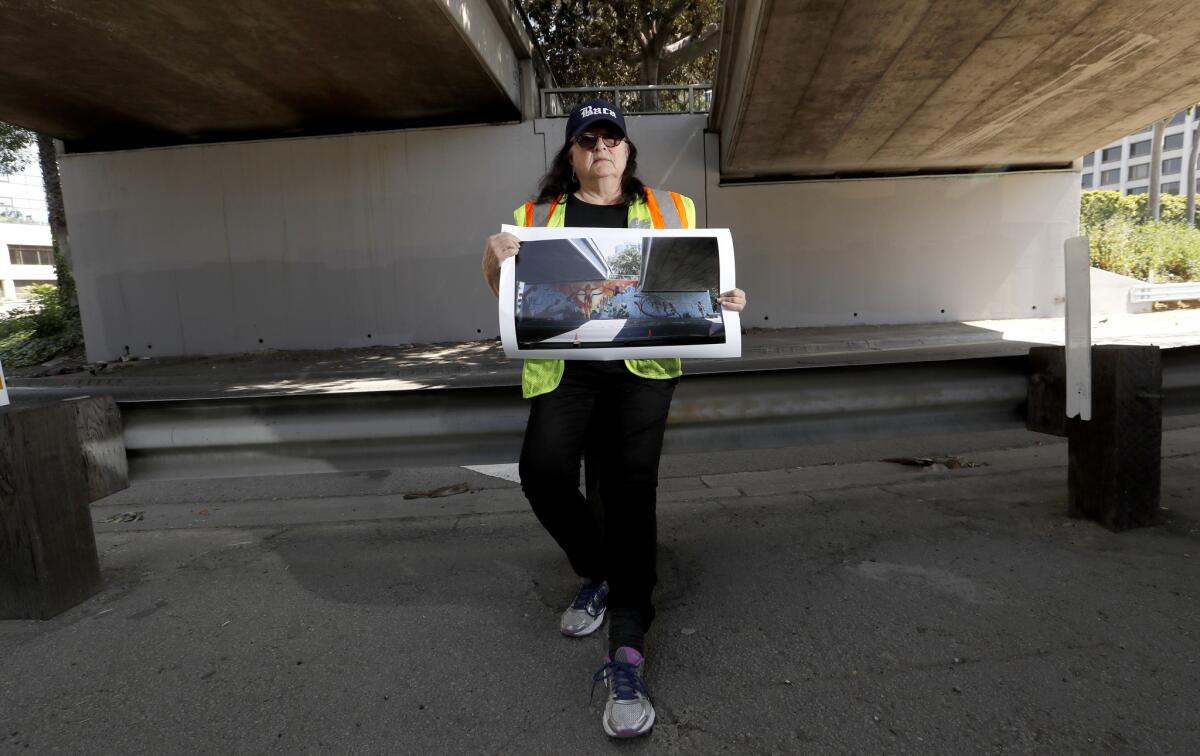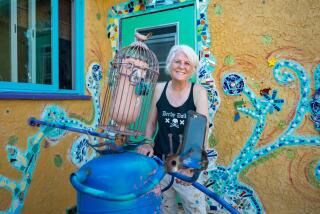Must Reads: A historic L.A. mural was whitewashed, and the artist is fed up with the lack of respect
Judy Baca saw the graffiti marring her giant mural of an Olympic runner as little acts of oppression. It was as if the taggers, who spray-painted big bubbly letters over the legs of the female athlete, wanted her to trip and fall on the home stretch.
But the Los Angeles artist was shocked when she learned that sometime in March — during Women’s History Month — someone had painted over the mural, concealing the woman entirely. The artwork, commissioned in 1984 and painted on the 110 Freeway near the 4th Street exit in downtown Los Angeles, commemorates the first time women were allowed to run in the Olympic marathon, at the 1984 Summer Games in L.A.
“Covering it in total was the ultimate act,” Baca said.
The mural is among a long list of L.A. artworks, including several other Olympic scenes, that have been whitewashed across the city in violation of federal and state laws. Like other artists, Baca said she is considering legal action against the agency she thinks is responsible: the California Department of Transportation.
“A mural of that size is worth millions and millions of dollars,” said Brooke Oliver, Baca’s attorney. “It is reprehensible that Caltrans doesn’t recognize that it is a tremendously valuable and revered mural in a high-profile place in Los Angeles and doesn’t give it the respect that it deserves.”
But Caltrans insists it is not the culprit and says the agency is willing to work with Baca to restore the artwork.
The Social and Public Art Resource Center (SPARC), a group headed by Baca that promotes art in the community, noted earlier this month that the 30-foot-high, 100-foot-wide mural titled “Hitting the Wall” had been painted over. The group posted a photograph of the blank, light-gray wall that replaced the iconic mural, which featured a female runner breaking a finish-line rope tied to two wooden pillars and then busting through a concrete block wall.
Baca, one of Los Angeles’ most respected artists and a UCLA professor, uses traditional Mexican techniques in her murals. “Hitting the Wall” was covered in a glaze that made it appear as though light were emanating from the turquoise bricks the runner breaks through. Applying the glaze is a laborious process that took nine months to complete.
Before she began work on the mural, Baca met with marathon runners and attended multiple races to develop the piece’s main character: one woman who represented the many female athletes the artist had encountered.

“Hitting the Wall” was one of at least 10 large freeway murals commissioned by the International Olympic Committee 35 years ago. Only a handful remain intact.
Baca was paid $15,000 for the piece, $3,000 of which went toward Caltrans-required barriers for the freeway, she said.
The artwork is copyrighted and registered with the city’s Department of Cultural Affairs. In accordance with the Visual Artists Rights Act, a 1990 law that protects recognized works of public art from damage, destruction or defacement, Baca should have received a 90-day notice if her mural was to be removed.
But neither the artist nor her staff received any such alert.
SPARC has worked with Caltrans for years to clean graffiti off Baca’s painting, according to Carlos Rogel, the group’s interim executive director. The state agency has jurisdiction over the area where the mural was painted.
The arts organization tried unsuccessfully to create a contract with the agency so it could more easily access the area and get paid for any repair work that was needed. Despite those efforts, no formal procedure has been created for mural maintenance in Caltrans’ jurisdiction, Rogel said.
Accessing the freeway is a dangerous and laborious process, requiring permission and supervision from Caltrans personnel, SPARC said. Freeway lanes would need to be closed for the large trucks, ladders and other equipment required to paint the wall. Because of that, SPARC feels certain the transportation department is responsible for the mural’s whitewashing.
“That’s not a small job,” Rogel said.
But Caltrans asserts it did not paint over the artwork.
John Bulinski, the agency’s district director, said GPS data was reviewed for all crews working in the region from Jan. 7 through March 4 and none were shown in the vicinity of Baca’s mural.
“While department staff may not be responsible for this, as members of the community, we are committed to making things right,” Bulinski said. “We plan to work with the artist and the Social and Public Art Resource Center to restore this historically significant mural.”
In some cases, artwork that has been lost can be restored or repainted elsewhere — but not always.
Lauren Wonder, a spokeswoman for Caltrans, said some artists have agreed to have their Olympic murals painted over after excessive tagging outweighed the cost and time it would take to clean and maintain the artwork.
Baca has vowed to restore the piece, although she doesn’t know the extent of its damage.
A protective coating developed by SPARC — which has become an expert in restoring defaced murals — covers the original artwork. But with the Baca mural painted over entirely, the group isn’t sure how effectively the new gray paint can be removed without damaging the art beneath it, Rogel said.
What could have been an easy and inexpensive graffiti removal job that would have taken only 30 minutes will now take at least a week to complete and cost up to $50,000, he said.
It’s not the first time a renowned artist’s work has been covered up without notice. The whitewashings have led to long legal battles and some costly settlements.
In 2008, L.A. artist Kent Twitchell won a $1.1-million settlement from the U.S. government and 11 other defendants after his iconic six-story mural “Ed Ruscha Monument” in downtown Los Angeles was removed without his knowledge. The mural could not be restored because holes had been drilled in the concrete wall, so Twitchell painted an updated portrait of an older Ruscha in L.A.’s Arts District.
Six years after Twitchell’s case, a Venice property owner was sued after a mural titled “Brooks Avenue Painting” was removed. The artwork, created in 1969 by Victor Henderson and a group called the Los Angeles Fine Arts Squad, appeared in a portrait of the rock band the Doors. Henderson alleged in his suit that the mural was expunged without his knowledge, and he won a settlement for an undisclosed amount.
In 2015, hours before the removal of the “Freedom” mural on the Prado Dam spillway in Corona, a federal judge cited the Visual Artists Rights Act when he issued a restraining order halting the process. Since then, attempts have been made to include the artwork — which was created by a group of high schoolers in 1976 to celebrate the nation’s bicentennial — in the National Register of Historic Places.
Eric Bjorgum, the attorney behind each of those cases, filed another lawsuit in 2017 on behalf of the artist Thrasher, whose Los Feliz mural titled “Six Heads” was painted over in 2014 without notice.
Thrasher’s artwork was removed so a mural of author Charles Bukowski could be painted there to promote a bar called Bukowski’s, according to Bjorgum, who is also president of the Mural Conservancy of Los Angeles.
The bar has since gone out of business, halting the legal process, but “Six Heads” still has not been restored.
Bjorgum called Baca’s mural one of the “crown jewels of Los Angeles” and a work of art that contributed to the city’s being a leader in public art. He was just as baffled as Baca as to why someone would paint over it.
Often, such episodes come down to a lack of communication between artists and property owners, with either disregard or ignorance of the law, he said.
“I would speculate [the mural] was being tagged, and Caltrans probably had enough,” Bjorgum said. “Frankly, artists and property owners get really angry because they feel like they can do what they want with their property.”
But Baca said the whitewashing of her mural goes beyond a lack of communication or knowledge of artist’s rights. She said its removal is a symptom of the general decline of support for public art in Los Angeles.
“It’s vigilantism,” she said. “They would rather paint on the mural than see even a mark of graffiti on the mural.”
alejandra.reyesvelarde@latimes.com
Twitter: @r_valejandra
More to Read
Sign up for Essential California
The most important California stories and recommendations in your inbox every morning.
You may occasionally receive promotional content from the Los Angeles Times.











